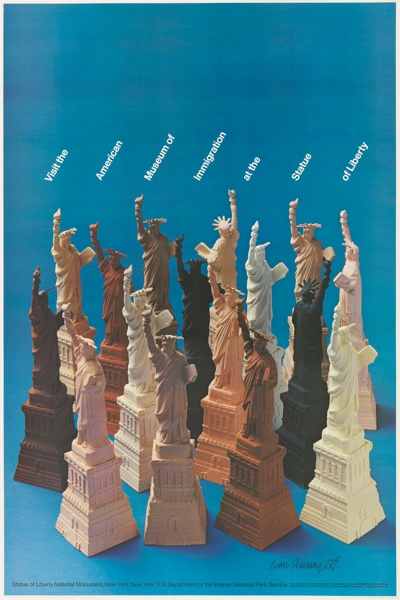The Immigration Museum that Pretended We’d Always Treated Immigrants with Kindness

Image courtesy the Cooper Hewitt Museum
Last Thursday’s announcement of a new museum on Liberty Island dedicated to the Statue of Liberty and its connection to America’s immigration story heralded a new chapter in Liberty Island’s institutional history. While the Ellis Island National Museum of Immigration has ably interpreted the stories of New York’s immigrants since 1990, few people know that Liberty Island once housed its own immigration museum, the American Museum of Immigration, located at the base of Lady Liberty’s pedestal.
Fundraising to establish the American Museum of Immigration began in 1955, spearheaded by President Eisenhower. At the museum’s formal dedication on September 26, 1972, President Richard Nixon declared, “let us dedicate ourselves to a great proposition that brought people to these shores—to make the American dream come true…. Let's give that opportunity to every American, whatever his background.” Nixon saw the museum’s dedication as a chance to throw in a few barbed remarks about the Soviet Union, comparing American freedom to Soviet coercion. Nixon’s comments were in keeping with the museum’s overall Cold War perspective on immigration. Glossing over inconvenient facts such as Chinese exclusion and the quota system, as historian Mike Wallace commented, the museum’s exhibits told a story of immigrants fleeing misery abroad and triumphing over adversity in America.
The museum’s Cold War narrative was purposely ignored by some of the American Museum of Immigration’s biggest boosters, the Emma Lazarus Federation of Jewish Women’s Clubs. The Emma Lazarus Federation, or ELF, was a collection of leftwing white Ashkenazi Jewish women from immigrant backgrounds who came of age in the garment industry’s labor movement. Since they had chosen Emma Lazarus, whose poem “The New Colossus” adorns the Statue of Liberty, as their figurehead, the ELF felt a special identification with the new museum in the statue’s base. ELF members launched a fundraising campaign in support of the museum in the mid-1950s, raising almost $5,000 in dimes to contribute towards the museum’s founding. This donation qualified ELF to be named a “Group Founder” of the museum. At a special presentation in June 1957, 300 members of ELF gathered at the Statue of Liberty. Mrs. Max Lazare, the chair of the New York Women’s Division of the Museum’s founding committee, told the assembled crowd that the museum would “enshrine the historical and cultural records of immigrants” who came to a new land on a “one-way ticket.”
Rose Nelson Raynes, an ELF leader born in the Ukraine in 1903, might have disagreed that immigration was a one-way ticket to American freedom. In October 1950, she was arrested under the terms of the McCarran Act on charges of being an alien affiliated with the Communist Party. She was held for 25 days without bail on Ellis Island, including nine days in solitary confinement. She could see the Statue of Liberty from her prison window.
In 1951, Rose Raynes lost her appeal and was ordered deported from the United States. Raynes’s case was not unique: in the 1940s and 1950s, several thousand men and women faced deportation on political grounds. Most had only briefly belonged to Communist-affiliated political organizations during the 1930s. The majority were middle-aged or elderly legal residents from central or eastern Europe, who had spent more than 25 years in the United States. At the same time, by 1955, deportation of Mexican migrants in the Southwest totaled over one million people. These two types of deportation were intrinsically linked: as Daniel Kanstroom remarked, “the threat of deportation was as integral to the labor system as it was to the ideological Cold War.”
Despite the fact that a number of their leaders faced deportation by the American government, the women of ELF visited the Statue of Liberty every summer for almost fifty years, laying a wreath of flowers next to the inscription of Emma Lazarus’s poem extolling the welcoming of immigrants into the fabric of American society. They were almost always accompanied by FBI agents, taking attendance.
Rose Raynes never left the United States, despite her deportation order. Since she was born in imperial Russia, the Soviet Union did not recognize her as a citizen and would not admit her. The United States could not find another country that would take her, and so she spent the rest of her life stateless, on American soil. She died in Brooklyn in 1994. When asked in 1979 by an oral history interviewer, “Has history vindicated you? Raynes replied, “Yes.”
Fundraising for the American Museum of Immigration met with increased opposition throughout the 1960s, as African Americans and other minority groups protested its triumphalist, Euro-centric message. Ultimately, the museum was neglected, and closed its doors in 1991 once Ellis Island opened its own, more contemporary immigration museum.
With the support of Jeff Bezos, Coca Cola, Michael Bloomberg, and Diane Von Furstenberg, Liberty Island’s new museum has a strong foundation. Its plans for a raised roof garden that doubles as a viewing platform of downtown Manhattan may also symbolize a new private-sector perspective to counter certain politicians’ plans to make undocumented immigrants self-deport. Time will tell.